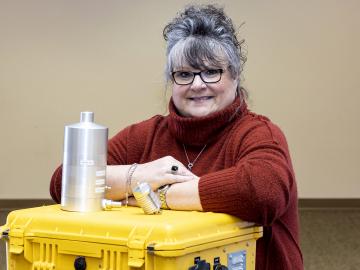
Filter News
Area of Research
- Advanced Manufacturing (1)
- Biology and Environment (23)
- Clean Energy (21)
- Computational Biology (1)
- Fusion and Fission (7)
- Fusion Energy (1)
- Isotopes (7)
- Materials (3)
- Materials for Computing (4)
- National Security (3)
- Neutron Science (6)
- Nuclear Science and Technology (1)
- Quantum information Science (2)
- Supercomputing (12)
News Type
News Topics
- 3-D Printing/Advanced Manufacturing (7)
- Advanced Reactors (1)
- Artificial Intelligence (4)
- Big Data (2)
- Bioenergy (9)
- Biology (14)
- Biomedical (6)
- Biotechnology (3)
- Buildings (5)
- Chemical Sciences (2)
- Clean Water (3)
- Climate Change (3)
- Computer Science (14)
- Coronavirus (3)
- Cybersecurity (1)
- Decarbonization (5)
- Energy Storage (8)
- Environment (23)
- Exascale Computing (2)
- Frontier (1)
- Fusion (1)
- Grid (3)
- High-Performance Computing (9)
- Isotopes (6)
- ITER (1)
- Materials (4)
- Materials Science (7)
- Mercury (3)
- Microscopy (3)
- Nanotechnology (3)
- National Security (4)
- Neutron Science (7)
- Nuclear Energy (4)
- Physics (2)
- Polymers (1)
- Quantum Computing (1)
- Quantum Science (4)
- Security (2)
- Space Exploration (1)
- Summit (4)
- Sustainable Energy (9)
- Transportation (9)
Media Contacts

In his career focused on energy storage science, Jianlin Li has learned that discovering new ways to process and assemble batteries is just as important as the development of new materials.

From Denmark to Japan, the UK, France, and Sweden, physicist Ken Andersen has worked at neutron sources around the world. With significant contributions to neutron scattering and the scientific community, he’s now serving in his most important role yet.

Through a consortium of Department of Energy national laboratories, ORNL scientists are applying their expertise to provide solutions that enable the commercialization of emission-free hydrogen fuel cell technology for heavy-duty

Toward the goal of bringing the next generation of nuclear power reactor technology online this decade, ORNL and Analysis and Measurement Services Corporation have successfully completed loop testing of instrument and control sensors for an advanced reactor design for small modular reactors.

Rich Giannone uses bioanalytical mass spectrometry to examine proteins, the primary driver in biological systems.

If a nation tries to hide a clandestine nuclear operation, Paula Cable-Dunlap and her team will give their all to help find it. Just don’t call their work “nuclear CSI” – not where she can hear, at least.

When COVID-19 was declared a pandemic in March 2020, Oak Ridge National Laboratory’s Parans Paranthaman suddenly found himself working from home like millions of others.

The Accelerating Therapeutics for Opportunities in Medicine , or ATOM, consortium today announced the U.S. Department of Energy’s Oak Ridge, Argonne and Brookhaven national laboratories are joining the consortium to further develop ATOM’s artificial intelligence, or AI-driven, drug discovery platform.

Oak Ridge National Laboratory was among an international team, led by Lawrence Livermore National Laboratory, who synthesized 108 elevated carbon dioxide, or CO2, experiments performed in various ecosystems to find out how much carbon is

When Kashif Nawaz looks at a satellite map of the U.S., he sees millions of buildings that could hold a potential solution for the capture of carbon dioxide, a plentiful gas that can be harmful when excessive amounts are released into the atmosphere, raising the Earth’s temperature.


